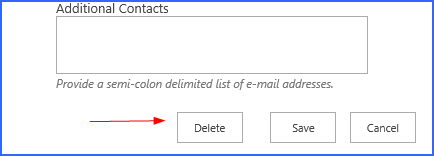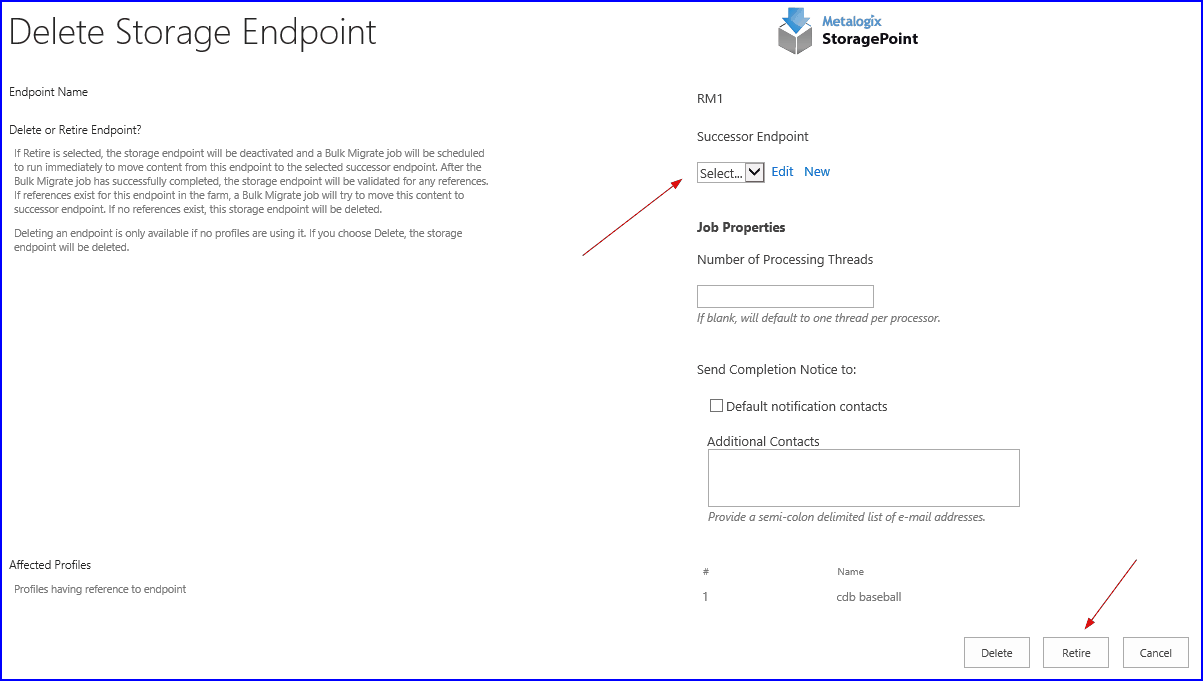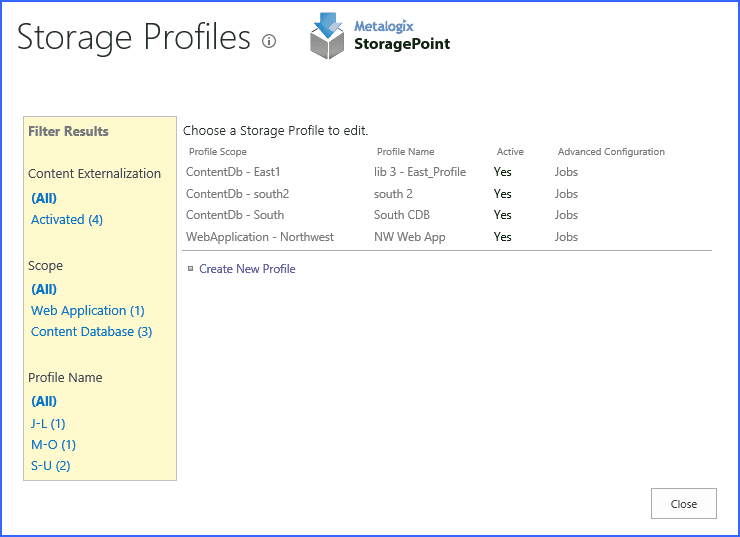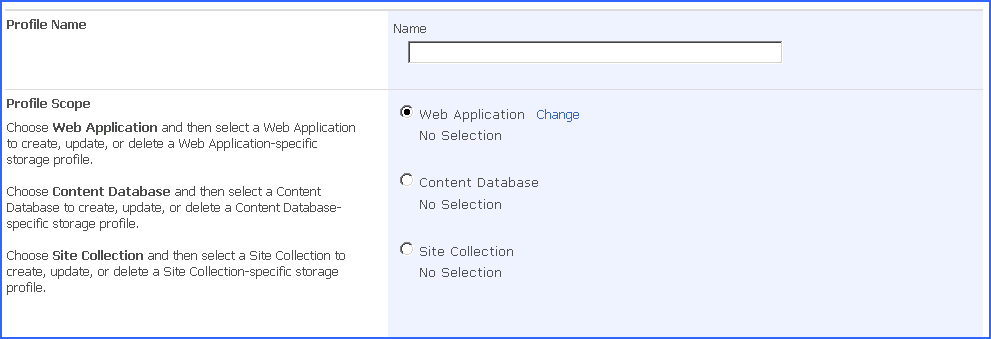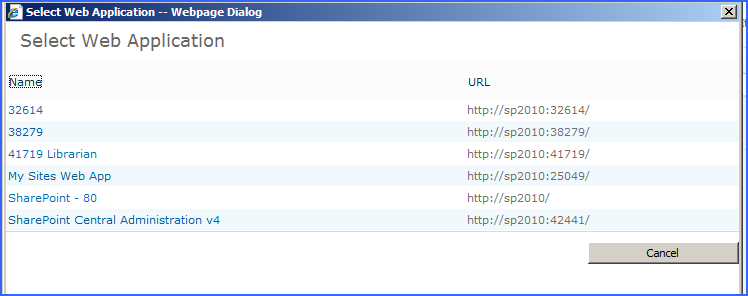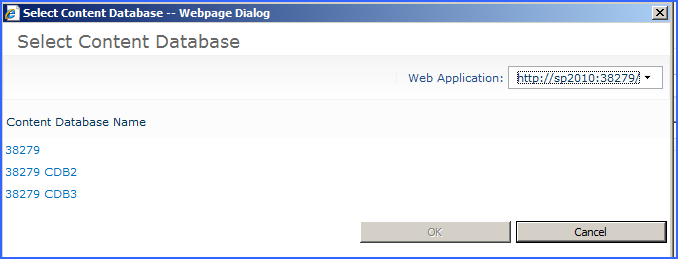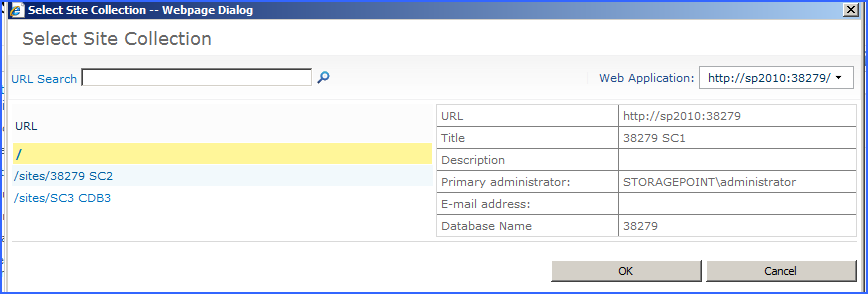Delete or Retire an Existing Storage or Backup Endpoint
While safeguards are in place to prevent externalized content from becoming irretrievable, deleting a storage endpoint is still an operation that should be carefully planned and completed.
1.Open the endpoint by clicking its name on the Storage and Backup Endpoints page.
2.Click Delete.
Storage endpoints that are associated with a Storage Profile cannot be deleted, and if attempted will return a message like this:
3.If there are other endpoints that can be used for that profile, the endpoint can be retired.
|
|
NOTE: Backup endpoints cannot be retired and a successor endpoint is not an option. Disable the Backup Sync settings on a profile to cease backing up BLOBs, or select a different backup endpoint for the profile. |
Select a Successor Endpoint from the dropdown, and click Retire. Selecting a successor endpoint wont be visible if there are not any profiles using the endpoint.
A bulk migration job will be performed automatically to move BLOBs from the retired endpoint to the selected successor endpoint, for each profile affected. The endpoint will be in a retiring state while this is going on.
4.If the endpoint can be deleted, it will be, and the Storage and Backup Endpoints page will load.
Deleting an endpoint makes all content on that endpoint read only.
Troubleshooting
Problem: Problems with Excel Services or other SSP service with Metalogix StoragePoint installed
1.When using the FileSystem adapter, make sure that the account under which the SSP Application Pool process is running has been granted access to the BlobStore.
2.Make sure that the account under which the SSP Application Pool process is running has been granted access to the Metalogix StoragePoint database. They will need both DataReader and DataWriter permissions.
Managing Storage Profiles
Storage Profiles dictate when and how content BLOBs will be externalized. They can be web application, content database, or site collectionscoped (EBS only). Storage Profiles can point to one or multiple endpoints. Storage profiles can be created manually, or as the result of a creating a File Share Librarian configuration. See File Share Librarian for more information.
Click the Storage Profiles link on the Application Management page in SharePoint Central Administration.
FILTERING THE STORAGE PROFILES
The pane on the left of the screen shows filtering options to narrow down the list of Storage Profiles. To view deactivated storage profiles, click the All option under Content Externalization before using the Scope or Profile Name filters.
Creating a New Storage Profile
1.Click the Create New Profile link. The Profile page opens.
2.Enter a unique Name for the Storage Profile.
3.In the Profile Scope section of the page, select a scope of the storage profile Web Application, Content Database or Site collection (EBS Only).
|
|
NOTE: Only SharePoint 2010 (using EBS) support Site Collection scoped profiles. The URL of the Site Collection will be a link that will open in a new window. |
4.Click the Change link next to the scope selection.
5.If Web Application was selected, a web application selection dialog will open.
6.Click the name of the web application for the scope of the profile. Go to Step 8.
7.If Content Database was selected, a content database selection dialog will open.
Change the Web Application to populate the list of content databases names. Click the name of the content database for the scope of the profile and click OK.
8.SharePoint 2010 users will see an additional selection for EBS or RBS. This will be even further restricted to RBS, if EBS has not been activated. 
Go to step 11.
9.If Site Collection was selected, a site collection selection dialog box will open.
10.Use the dialog to find the site collection. Enter all or part of a URL into the URL Search box or change the Web Application to populate the URL list. Select the URL for the scope of the storage profile and click OK.
11.In the Storage Endpoints section of the page, decide whether or not to externalize content BLOBs and how.
|
|
CAUTION: Do not use the same endpoint for more than one farm, i.e. development, staging, and production. This is not a supported configuration. |
|
Storage Setting |
Value/Options | ||
|
·The Archive Only option only works if Asynchronous is selected in the Endpoint Selection Mode field. ·Switching the profile between these options will require an iisreset and timer service stop and start. |
No content from lists (attachments) and libraries will not be externalized. Yes content from lists (attachments) and libraries will be externalized. (default) Archive Only Archiving can be configured for the scope of the profile, but nothing will be externalized until archiving conditions are met. | ||
|
|
Synchronous the configured endpoints are evaluated as content is uploaded into SharePoint (default). Asynchronous the configured endpoints are evaluated by the Content Migrator job after control is returned to the end user. BLOBs are immediately written to the System Cache. See Synchronous versus Asynchronous for more explanation on the differences. |
12.Click Add Endpoint to select an existing configured endpoint or configure rules for the different endpoints to which to send BLOBs. From the New Profile Endpoint page:
a.Use the dropdown to select an existing storage endpoint OR
b.Click Edit to change the configuration of an existing storage endpoint (see Editing an Existing Storage or Backup Endpoint) OR
c.Click New to create a new storage endpoint for this storage profile (see Creating a New Storage or Backup Endpoint).
The chart below shows how to configure a storage rule for the storage endpoint of the storage profile. Because there can be more than one storage endpoint per storage profile, keep in mind how the BLOBs will be filtered. For example, a profile could be created where all content less than 500KB is written to Windows Azure BLOB Storage and all content greater than or equal to 500KB is written to an on premise (i.e. NAS or SAN) BLOB store. Its also important to note that Metalogix StoragePoint will only write to the first online endpoint where the Storage Rule evaluates to TRUE.
|
|
NOTE: If the profile has a content database scope and is using using RBS, there will have to be at least one unfiltered endpoint. The only exception to this is if the filter is a file size greater than or equal to (>=) rule. This is not a requirement of EBS because Metalogix StoragePoint can refuse to externalize the BLOB which will cause SharePoint to store it in the content database. RBS does not provide the option to refuse externalization of the BLOB. |
|
Endpoint |
Select an endpoint, or click the New link to create a storage endpoint. Follow the steps in the Creating a New Storage or Backup Endpoint. | ||
|
Endpoint Start Folder |
Change the starting folder of content externalized to this storage endpoint, from this storage profile. This folder would come before the storage endpoint foldering settings that were configured when the storage endpoint was created. | ||
|
Online? |
Yes This endpoint is available for content to be externalized, for this profile. (default) No This endpoint is NOT available for content to be externalized, for this profile. | ||
|
SharePoint 2010 only. This option is available only for asynchronous profiles in SharePoint 2013 and newer.
|
The File size filter, if checked, will use the entered value in KB and the operator (>= or <=) to determine if the endpoint should be used to externalize the content BLOB.
For example, would indicate that only files greater than or equal to 100KB in size should be externalized to this endpoint. |

